The nominations are in, the votes have been counted and the Universe Today writers have been consulted; the Top 10 Scientific Endeavours of 2008 are decided! After much consideration by the readers of the Universe Today, it became quickly apparent what the popular choice would be, and some of the Top 10 may not come as a surprise. However, there are some nominations we weren’t expecting, and certainly cannot be found on any other “Top 10” list. Therefore, I believe the Universe Today’s Top 10 Scientific Endeavours of 2008 is the most comprehensive list out there, combining the votes of our readers, nominating a huge variety of articles available through one of the biggest space news websites on the Web.
For more information about the motivation behind the Universe Today’s Top 10, be sure to check out the nominations page…
Without further ado, here is the Universe Today’s definitive Top 10 Scientific Endeavours of 2008…
10. Chandra X-ray Observatory
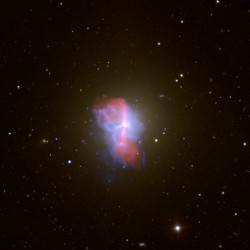
Chandra has benefited our understanding of the cosmos in so many ways, it is hard to single out one endeavour. In 2008 alone, it has been used to “weigh” supermassive black holes, it has spotted the X-ray echo of stars being ripped apart in the centre of galaxies, it has also seen the echoes of supernovae, taken data supporting the existence of magnetars, found evidence supporting the theory of dark matter and linked the existence of dark energy with the growth of galactic clusters.
In short, Chandra is an astounding mission, continuing to shape our understanding of known X-ray phenomena, providing us with a glimpse at the answers to some of the most puzzling questions of our time. Certainly one of the “Great Observatories”.
For more, check out The Universe Today articles filed under the category “Chandra”.
9. Epsilon Eridani
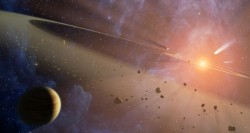
In 2008, further work has been done analysing the structure of the Epsilon Eridani system and there is even more evidence to suggest the star system is the Solar System’s “twin”. Although the star itself is slightly smaller and cooler than the Sun, it does possess several unseen planets, creating an asteroid belt much like ours, plus an outer belt (analogous to our Kuiper Belt, but 20-times bigger). Regardless of the similarities between the Solar System and Epsilon Eridani, it is a phenomenal achievement to probe an alien star system, over 10 light years away, with such precision.
For more, check out “Spock’s Solar System Looks Like Ours”.
8. Galaxy Zoo’s discovery of Hanny’s Voorwerp
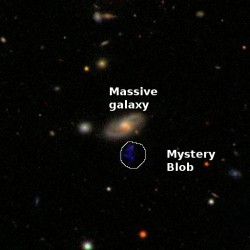
“Our working hypothesis is that Hanny’s Voorwerp consists of dust and gas (maybe from a tidally disrupted dwarf galaxy) which is illuminated by a quasar outburst within IC 2497, an outburst which has faded dramatically within the last 100,000 years.”
Galaxy Zoo is a superb example on how enthusiasts can use an Internet-based system to observe and identify objects in the cosmos. I am sure Hanny’s Voorwerp will continue to captivate professionals and amateurs, ensuring Galaxy Zoo’s popularity through 2009 and beyond…
For more, check out “Galaxy Zoo Gets a Makeover”.
7. MESSENGER
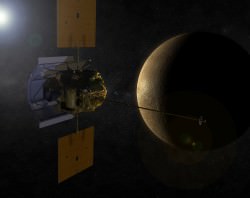
In January 2008, MESSENGER performed its first Mercury flyby. This is the first time for 30 years that the smallest planet* in the Solar System has been visited by a space mission (since the 1975 Mariner 10 mission flyby). There will be one more Mercury flyby until MESSENGER’s delta-v (change in velocity) has been slowed significantly to allow the spacecraft to be captured by the planet’s gravitational pull. During the January flyby, MESSENGER managed to capture some stunning images of the planet from an altitude of 200km. Then, in October the spacecraft made its second pass over Mercury’s surface from the same distance, revealing even more detail of the cratered, rocky surface.
After 3 decades, the mysterious planet, famous for being the closest planet to the Sun, is gradually revealing its secrets.
For more, check out “More Mercury from MESSENGER”.
*Of course, when MESSENGER was launched, it was travelling to the second smallest planet in the Solar System. As Pluto was demoted in 2006, Mercury is now the smallest planet, whereas Pluto is a “dwarf planet” or a “Plutoid”.
6. First exploding supernova observed
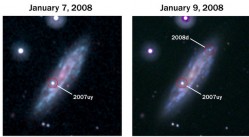
“It’s a really lucky chain of events — a surprise,” said Alicia Soderberg, who is leading the group studying data from the explosion. “It was all over in a matter of minutes.”
This discovery is critical to understanding the science behind the final moments of a massive stars life, improving and advancing stellar models.
For more, check out “Caught in the Act: Astronomers See Supernova As it Explodes“.
5. The Large Hadron Collider
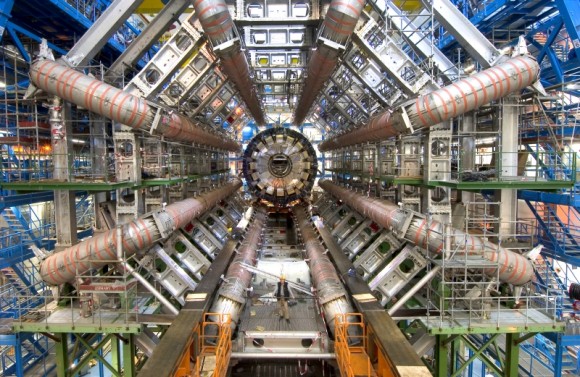
2008 has been the year for particle accelerator physics. The Large Hadron Collider (LHC) is the biggest physics experiment ever built, primarily to search for the elusive Higgs boson (the “force carrier” of the Higgs field that is theorized to permeate through the entire Universe, giving matter its mass), is as famous as it is infamous.
Early in the year, months before the 27km-long particle accelerator ring went online to circulate its first protons, the world’s media was abuzz with the possible science that could revolutionize physics as we knew it. However, there’s a flip-side to that coin. There was an increasing opposition to the LHC, culminating in attempted legal action (that ultimately failed), based on the flawed thinking that the LHC could generate dangerous micro black holes, strangelets and a host of other hypothetical particles. This only served to stir up international interest in what the LHC was actually going to do, and by October 10th, a mix of concern and excitement built up to the grand “switch on”.
The first circulation was a success, proving the LHC worked and CERN scientists readied the most powerful particle accelerator for its first particle collisions. Unfortunately, the LHC hit its first stumbling block only days after the first online tests, culminating in a damaged transformer. However, even worse news was to come. A “quench” triggered by an electrical short between two of the superconducting magnets caused severe damage to one of the sections, knocking it offline for months while engineers make repairs. It now looks as if the LHC will recommence operations mid-2009.
Although many would argue the LHC shouldn’t be included in a “Top Ten Scientific Discoveries” (like Time Magazine’s Top Ten), as it hasn’t actually discovered anything yet, the LHC is a huge science and engineering endeavour, where its construction is as ground-breaking as the potential science it will be producing later this year.
For more, check out all the LHC articles on the Universe Today.
4. Cassini explores Saturn’s moon Enceladus
Having recently completed its initial four-year tour of duty around the ringed planet, Cassini had its mission extended through September 2010. In August 2009, the Sun will shine directly on Saturn’s equator, illuminating the northern hemisphere. It is for this reason, the new phase of Cassini’s operations has been called the “Cassini Equinox Mission”.
The principal reason for extension is to find answers to some of the most perplexing questions raised during the spacecraft’s flybys of the Saturnian moons, principally Enceladus, the small 500km-diameter natural satellite. Enceladus may only be a tenth of the size of Titan (Saturn’s biggest moon) but it is one of the most intriguing.
This year, far from being “just another” frozen moon, Enceladus has shown itself to be surprisingly dynamic, revealing complex plate tectonics and ejecting plumes of water as powerful geysers (of which Cassini has flown through and analysed). This has of course led to some interesting ideas about the potential for life in tidally-heated liquid water subsurface lakes.
“Of all the geologic provinces in the Saturn system that Cassini has explored, none has been more thrilling or carries greater implications than the region at the southernmost portion of Enceladus,” said Carolyn Porco, Cassini imaging team leader.
For more, check out the Universe Today’s articles all about Enceladus.
3. SpaceX makes commercial spaceflight history
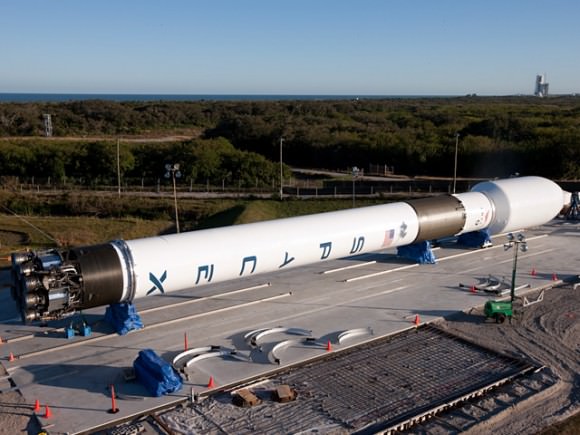
In August, the world watched in anticipation as SpaceX made its third attempt at becoming the world’s first commercial space flight company to launch a payload into orbit. Unfortunately, Flight 3 of the SpaceX Falcon 1 rocket became the third Falcon to fail, exploding high in the atmosphere after a stage separation (transient thrust) anomaly. It was a sad day not only for Elon Musk’s dream of providing affordable launch capabilities, but also for the promise of commercial space flight.
But in the true entrepreneurial spirit Musk has become synonymous with, his company turned Flight 3’s loss into a motivation to get it right the fourth time around. Only one month later, the Falcon 1 was readied for Flight 4 from the Kwajalein Atoll launch pad. On September 28th, SpaceX was propelled into the history books as the first ever private space company to design, build and launch a payload (albeit a “dummy” payload) into orbit.
Now SpaceX has proven itself to the world, the future has become very bright for commercial spaceflight. SpaceX not only got into orbit, they did it cheaply and quickly, setting the bar very high for its competitors. They also have a bold vision for the future; building bigger and more powerful rockets (the Falcon 9 for example), launching not only from the South Pacific, but also from the home of rocket launches: Cape Canaveral.
To top it all off, NASA has signed contracts worth $2.5 billion for private launch capabilities over the next decade, with SpaceX receiving a $1.6 billion share. All in all, it has been an outstanding year for SpaceX, and it looks like they might even be ready to supply the International Space Station in 2009, so watch this space.
For more, check out the SpaceX articles on the Universe Today.
2. Imaging exoplanets
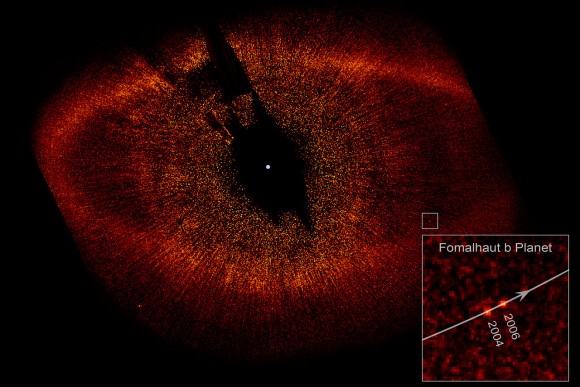
We’ve known for many years that exoplanets orbit other stars and have observed them indirectly by looking at star “wobble” (due to gravitational effects of a massive exoplanet as it orbits) and exoplanet transits (as the planetary body passes in front of the star, reducing the amount of light received on Earth). This year astronomers went one better, they observed exoplanets directly, imaging the little dots as they orbit their host stars.
However, this honour doesn’t go to just one observatory, it goes to several. On November 13th, the Hubble Space Telescope team announced they have taken the first direct visible light images of an exoplanet orbiting the star Fomalhaut, 25 light years away. On the same day, a press release from a joint Keck and Gemini telescope campaign announced the first direct infrared images of multiple planets orbiting a star called HR8799, 140 light years away.
As if that wasn’t enough, on November 21st, astronomers using the ESO Very Large Telescope detected an exoplanet in a very compact orbit around Beta Pictoris, 70 light years from Earth.
These stunning glimpses of exoplanets have been made possible by the huge technological advancement in both ground-based and space-based observatory optics. Astronomers are now confident that they can go one step further as telescopes and techniques improve… how about looking for exomoons orbiting these exoplanets? Wow…
For more, check out the Universe Today’s Extra-Solar Planets category.
1. Phoenix Mars Lander
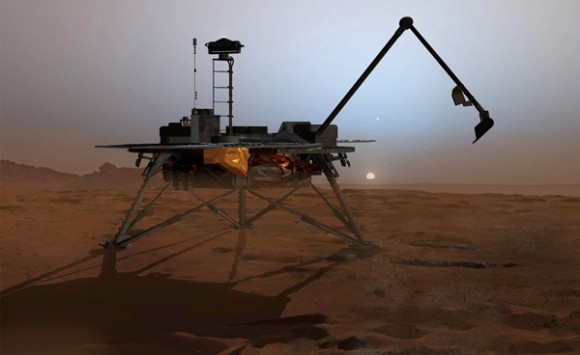
In May, the Phoenix Mars Lander captured the world’s attention as it entered the Martian upper atmosphere to begin its “7 minutes of terror“, including a fiery re-entry, fast decent and rocket-powered controlled landing. The robotic lander touched down in the frozen arctic region of the planet to begin its three month campaign with panache. The mission was extended to five months as Phoenix wrestled with the dwindling winter sunlight powering its solar panels and battled against troublesome dust storms.
During its stay on Mars, Phoenix confirmed the presence of water ice, discovered a life-hindering (or, possibly, life-supporting) chemical called perchlorate, observed Martian weather conditions and generally aided our understanding of this unforgiving region of the Red Planet using its advanced suite of automated ovens and mini laboratories.
This mission was also remarkable for the efforts carried out here on Earth by the Phoenix team at NASA and the University of Arizona communicating cutting-edge and up-to-the-minute science via a variety of social platforms. Scientists blogged and Twittered from the moment the mission was launched to the moment Phoenix finally succumbed to a frozen coma in early November (and MarsPhoenix continues to tweet regular data analysis updates).
However, this short mission joined the two rugged Mars Exploration Rovers Spirit and Opportunity soldiering through the elements for the last five years, after repeatedly having their missions extended over four years past their warranty. Add these incredible surface missions to the armada of satellites (NASA’s Mars Reconnaissance Orbiter, Mars Odyssey and the European Space Agency’s Mars Express), and it becomes obvious that international efforts to study Mars have turned the once mysterious, dusty red globe into one of the most studied planetary bodies of the last decade.
*****
So, Phoenix and the continuing Mars program overwhelmed the popular vote in the Top 10 Science Endeavours of 2008, winning the number one spot convincingly. This was a very tough “Top 10” to compile, but with the help of Universe Today readers, the list became more varied than we could have possibly hoped.
Naturally, many worthy science endeavours didn’t make the cut and here’s the runners up:
Supermassive black hole confirmation at centre of Milky Way
ESA Automated Transfer Vehicle (ATV) Jules Verne
Imaging solar transition region with sounding rocket
Spectral analysis confirms detection of ethane on Titan
The Universe Today’s Top 10 Scientific Endeavours of 2008 highlights some of the huge scientific advances we have made in the last 12 months. 2009 promises to be even bigger, and with the help of the organizers of the International Year of Astronomy, global efforts in space won’t only be recognised, they will be celebrated.


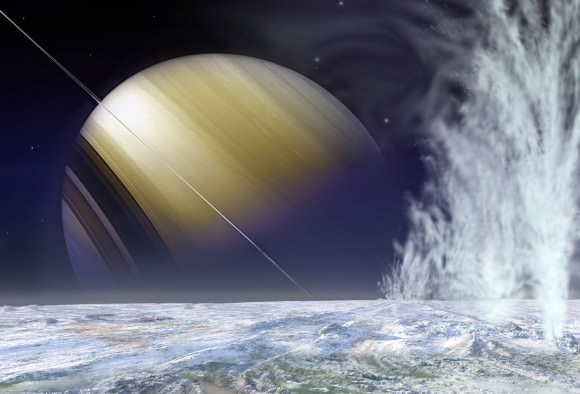
Very nice article and good overview of major scientific events last year.
Awesome! 😀
Wonderful Article
Nice!! 😉
Pssst… don’t you think it should be “bear his name” in the section about Chandra? 😉 Thanks for the interesting list!
What SpaceX did was great, but does it really qualify as a “scientific” endeavo(u)r? Perhaps you can do a separate list of engineering/technical accomplishments and put that on top of that list, and leave this list to science?
Nice work everyone. Couldn’t fault the winners or runners up in any way! Also, cheers to Ian for doing the hard work!
Ian,
Glad I didn’t have your job of picking for this list. It had to be a tough call on whether to list Phoenix or exo-planets as number one. As usual, great article. The artist rendition you picked to accompany the entry for Cassini was a real eye catcher. I can only imagine what it would be like to stand on Enceladus and see Saturn like that. You left UT off the list. It doesn’t matter how good the science is if somebody doesn’t get the word out. You do a mighty fine job of that.
Great article but I am not sure why Phoenix qualifies as Number one. Exo-planets strike me as more important from a scientific point of view no?
WOW! Now if we can all just stand together and get a lander of some sort to Enceladus. Ill donate my whole annual salary. < Not that it would make a difference!